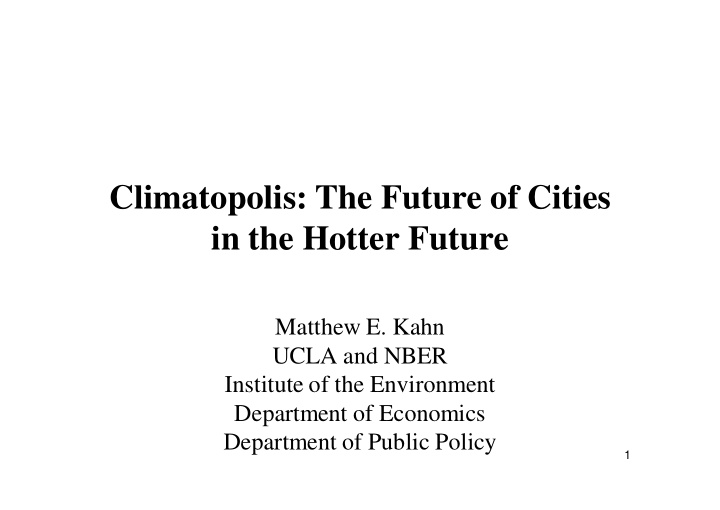



Climatopolis: The Future of Cities in the Hotter Future Matthew E. Kahn UCLA and NBER Institute of the Environment Department of Economics Department of Public Policy 1
Introduction • The World is unwilling to cap GHG emissions • Chapter One of Climatopolis is titled “Too Much Gas”! • Climate Change is coming • Low probability, ugly scenarios become more likely --- but we know this! • Climatopolis = the microeconomic “small ball” of how households and firms respond to “known unknowns”
My Book in a Nutshell • In 2030, 60% of the world’s population will live in cities • Climatopolis examines the future of cities in the face of climate change • An optimistic book --- we have the right incentives to invest to protect ourselves against emerging threats, • We have enough time to prepare and innovate • The Economist’s Review and Moscow’s Horrible Heat Wave in the Summer of 2010
Climate Change’s Likely Impacts on Our Cities • Different Cities around the world will face some combination of: • 1. Average hotter temperature and more extreme temperature events • 2. sea level rise and flooding • 3. water scarcity • Climate scientist: can and will quantify this risk, such measurement is their job!! • Assumption of “forecast convergence”
My Book’s Core Questions • How will climate change affect urban quality of life in developed and developing country cities? • How will urbanites, urban firms and urban politicians respond to the challenges posed by climate change? • If a specific city’s quality of life deteriorates, who suffers? � land owners! • An irony: Capitalism has caused climate change but capitalism will go a long way to protecting us from climate change.
The San Diego Foundation’s 2050 Study “A Regional Wake Up Call” • Useful Case Study • 4 degrees hotter on Average • Sea level will be 12-18 inches higher. • water demand up 37% while supply will down 20% • Wildfires will be more frequent and intense. • Public health will be at risk, (kids and elderly) • Peak electricity consumption up 70%
How Will Households and Firms Respond to these Predictions? • Hotter climate --- up zone in temperate areas • Alleviate water and electricity “scarcity” by allowing prices to rise • The induced innovation hypothesis posits that for profit firms will respond to these expected price increases • Wildfire and other disaster risk --- zoning and insurance contracts to encourage precautions • High frequency information provision --- heat waves, smog alerts
Escape from San Diego? • What if none of my predictions play out? • If a city such as San Diego’s quality of life suffers due to climate change, home owners there suffer an asset loss • Households there can migrate to a Detroit or another city whose quality of life is relatively better • Migration acts as an implicit insurance policy • Internet and “twitter world” keeps us fully informed about evolving threats
Government’s Role? • Carbon pricing (mitigation efforts would certainly help adaptation efforts) • Trusted information provider concerning new risks • Effective land zoning • Allowing prices of increasingly scarce resources (water and electricity) to rise to reflect fundamental scarcity • Recognize that “Sea Walls” crowd out private self protection
Adaptation in LDC Cities • Same challenges but fewer private resources for coping with shocks • Kahn (2005): The Death Toll from Natural Disasters • Income growth protects the population from agricultural price risks, health shock risks, • Income allows one to purchase higher quality housing reducing mortality and morbidity risk
Coping with Climate Change in the Developing World • Economic development as the best adaptation strategy • Farmer suffering � urban migration and the challenges of absorbing such “environmental refugees” • The Future of Bangladesh?
Free Trade is a “Friend” of Adaptation • Cities in nations that are open and do not impose tariffs on food imports will suffer less from food price volatility • Similar to Paul Romer’s point that ideas are public goods; the diffusion of new products such air conditioning, electric vehicles, renewable power will help LDCs to adapt
Conclusion • In 2011, an under appreciation of the power of free markets to help us adapt to evolving threats • Some of us are “Homer Simpson” but this actually helps us to adapt! • Is my book dangerous? Lulling concerns • Carbon Mitigation and adaptation are complements • But, my critics worry that the public will view them as substitutes
Basic Books September 2010
Recommend
More recommend